
Johannes Erwin Eugen Rommel, popularly known as The Desert Fox, was a German Generalfeldmarschall during World War II. He served in the Wehrmacht of Nazi Germany, as well as in the Reichswehr of the Weimar Republic, and the army of Imperial Germany.

The Normandy landings were the landing operations and associated airborne operations on 6 June 1944 of the Allied invasion of Normandy in Operation Overlord during the Second World War. Codenamed Operation Neptune and often referred to as D-Day, it is the largest seaborne invasion in history. The operation began the liberation of France, and the rest of Western Europe, and laid the foundations of the Allied victory on the Western Front.

During World War II, Operation Gaff was the parachuting of a six-man patrol of Special Air Service commandos into German-occupied France on Tuesday 25 July 1944, with the aim of killing or kidnapping German field marshal Erwin Rommel.

Cornelius Ryan was an Irish journalist and author known mainly for writing popular military history. He was especially known for his histories of World War II events: The Longest Day: 6 June 1944 D-Day (1959), The Last Battle (1966), and A Bridge Too Far (1974).
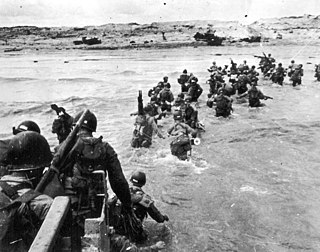
Utah, commonly known as Utah Beach, was the code name for one of the five sectors of the Allied invasion of German-occupied France in the Normandy landings on June 6, 1944 (D-Day), during World War II. The westernmost of the five code-named landing beaches in Normandy, Utah is on the Cotentin Peninsula, west of the mouths of the Douve and Vire rivers. Amphibious landings at Utah were undertaken by United States Army troops, with sea transport, mine sweeping, and a naval bombardment force provided by the United States Navy and Coast Guard as well as elements from the British, Dutch and other Allied navies.

La Roche-Guyon is a commune in the Val-d'Oise department in Île-de-France in northern France. It is located in the Vexin regional nature park, and is a member of Les Plus Beaux Villages de France Association.

Hans–Ulrich Freiherr von Luck und Witten, usually shortened to Hans von Luck, was a German officer in the Wehrmacht of Nazi Germany during World War II. Von Luck served with the 7th Panzer Division and 21st Panzer Division. Von Luck is the author of the book Panzer Commander.
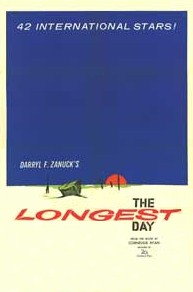
The Longest Day is a 1962 American epic historical war drama film based on Cornelius Ryan's 1959 non-fiction book of the same name about the D-Day landings in Normandy on June 6, 1944. The film was produced by Darryl F. Zanuck for 20th Century Fox, and is directed by Ken Annakin, Andrew Marton, and Bernhard Wicki. The screenplay was written by Ryan, with additional material written by Romain Gary, James Jones, David Pursall and Jack Seddon.

The Longest Day is a board wargame published by Avalon Hill in 1979 that simulates the Allied D-Day invasion of June 1944 and the subsequent Normandy campaign during World War II until August 31st, 1944.

Hans Speidel was a German military officer who successively served in the armies of the German Empire, Nazi Germany and West Germany. The first general officer of the Bundeswehr, he was a key player in West German rearmament during the Cold War as well as West Germany's integration into NATO and international negotiations on European and Western defence cooperation in the 1950s. He served as Commander of the Allied Land Forces Central Europe (COMLANDCENT) from 1957 to 1963 and then as President of the German Institute for International and Security Affairs from 1964.

Major Reginald John Howard DSO was a British Army officer who led a glider-borne assault that captured the Caen canal and Orne river bridges on 6 June 1944, as part of the D-Day landings during the Second World War. These bridges spanned the Caen Canal and the adjacent River Orne, and were vitally important to the success of the D-Day landings. Since the war, the bridge over the canal has become known as "Pegasus Bridge," a tribute to the men who captured it. The bridge over the River Orne later became known as Horsa Bridge after the Horsa gliders that carried troops to the bridges.
Wolfgang Preiss was a German theatre, film and television actor.

The Desert Fox is a 1951 American biographical war film from 20th Century Fox about the role of German Field Marshal Erwin Rommel in World War II. It stars James Mason in the title role, was directed by Henry Hathaway, and was based on the book Rommel: The Desert Fox by Brigadier Desmond Young, who served in the British Indian Army in North Africa.

Five Graves to Cairo is a 1943 war film directed by Billy Wilder and starring Franchot Tone and Anne Baxter. Set in World War II, it is one of a number of films based on Lajos Bíró's 1917 play Hotel Imperial: Színmű négy felvonásban, including the 1927 film Hotel Imperial. Erich von Stroheim portrays Field Marshal Erwin Rommel in a supporting performance.

Operation Overlord was the codename for the Battle of Normandy, the Allied operation that launched the successful liberation of German-occupied Western Europe during World War II. The operation was launched on 6 June 1944 (D-Day) with the Normandy landings. A 1,200-plane airborne assault preceded an amphibious assault involving more than 5,000 vessels. Nearly 160,000 troops crossed the English Channel on 6 June, and more than two million Allied troops were in France by the end of August.
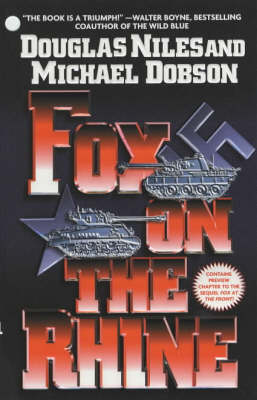
Fox on the Rhine is a 2000 alternate history novel written by Douglas Niles and Michael Dobson. It details a course of events over late 1944 that resulted from Adolf Hitler's death in the July 20 plot and from Field Marshal Erwin Rommel's survival of the crackdown.
Allemant is a commune in the department of Aisne in the Hauts-de-France region of northern France.
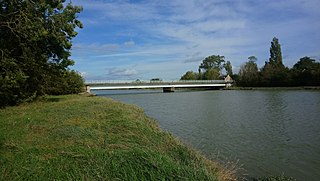
Horsa Bridge, also known as Ranville Bridge, over the Orne river, was, along with Pegasus Bridge, captured during Operation Tonga by gliderborne troops of the 2nd Oxfordshire and Buckinghamshire Light Infantry in a coup de main operation in the opening minutes of D-Day, 6 June 1944. The seizing of both bridges was considered to be critical to securing the eastern flank of the Normandy landings area, preventing German armour from reaching the British 3rd Infantry Division which was due to start landing on Sword at 07:25. Horsa Bridge, a road bridge, was over 400 yards east of Pegasus Bridge towards the village of Ranville.
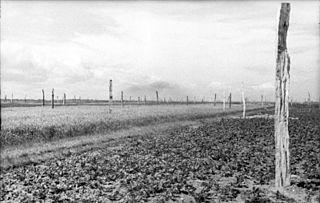
Rommel's asparagus were 4-to-5-metre logs which the Axis placed in the fields and meadows of Normandy to cause damage to the expected invasion of Allied military gliders and paratroopers. Also known in German as Holzpfähle, the wooden defenders were placed in early 1944 in coastal areas of France and the Netherlands against airlanding infantry. Rommelspargel took their name from Field Marshal Erwin Rommel, who ordered their design and usage; Rommel himself called the defensive concept Luftlandehindernis.
Major Richard Arthur Amyas Smith was a British Army officer who served during the Second World War. He was awarded a Military Cross for gallantry and leadership whilst serving as a platoon commander in the gliderborne 2nd Oxfordshire and Buckinghamshire Light Infantry coup de main operation; tasked to capture Pegasus Bridge and Horsa Bridge during the opening minutes of D-Day, 6 June 1944. The capture of both bridges was considered to be critical to securing the left flank of the Normandy landings area.

















